Sometimes we learn from the past, often we do not. Nolen’s book on improving our city devotes many pages to the waterfront. In 1913, when Nolen compiled his study, the area was a total, chaotic mess. On page 49 of his book, he writes “The great hope of Erie for the future is its waterfront. At present, however, the waterfront and harbor of Erie contribute very little indeed to the business development of the city or to the pleasure of its citizens.” Haven’t we all heard those similar words spoken in the not so recent past? The GAF site along the bayfront has been discussed for years.
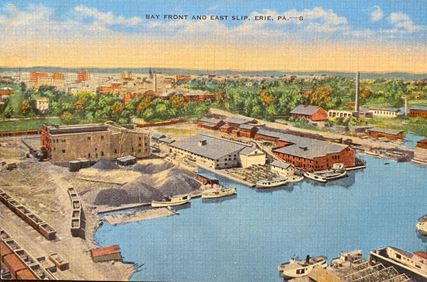
The Erie harbor is considered one of the finest on the Great Lakes. The size, depth of water and protection offered by the peninsula make it near perfect. Unfortunately, the city owned almost none of the land. Private ownership, along with private reasons for owning the land led to a mismatch of resources and possibilities. The Pennsylvania Railroad established an inexpensive and disorderly arrangement for the movement of materials from ships to trains. The only way to access the harbor was via State Street with the bluff inhibiting other forms of transportation such as wagons and the new invention of cars. Nolan adds “just because our harbor is better, if it doesn’t have efficient infrastructure, no one will use it.”
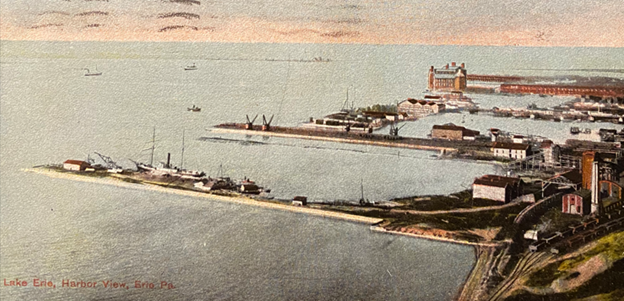
Nolan identified 4 types of freight that needed to be moved and that a coherent plan by one entity (the city) be established. He said Erie should plan for: the immediate transfer of freight from ship to train; storage facilities for later shipment; material necessary for the city’s manufacturers; and goods that were to be consumed by the general population. To my knowledge, none of that planning and infrastructure ever occurred. Could this be why Erie never grew to its potential?
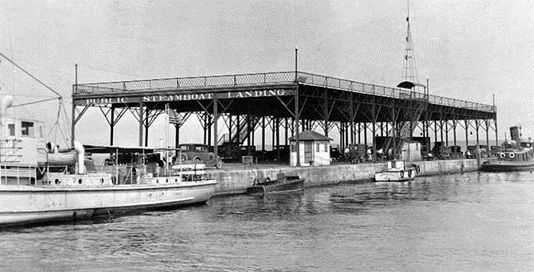
The Erie Steamboat Landing was built in 1909 by the city of Erie at a cost of $150,000 ($4,883,670.00 today) by the State of Pennsylvania. It is 100 feet wide and 55 feet long. It was renamed in 1966 as the Public Dock, then in 1986 it became known as Dobbins Landing. Daniel Dobbins was the mariner who convinced President Madison that a fleet of ships needed to be built on Lake Erie to stop the British during the War of 1812. The dock was seen as an improvement of the chaos that existed in that space.
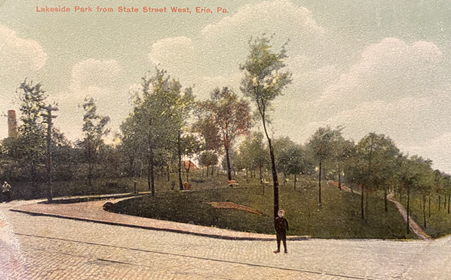
The other aspect of Erie’s waterfront that failed and still fails at is public access. The S.O.N.S. of Lake Erie are huge proponents of making sure the citizenry has use of our harbor today. THANK YOU! In 1913, only small Lakeside Park, which was only partly developed, existed. Today, a sidewalk exists along the waterfront and some people fish in the area.
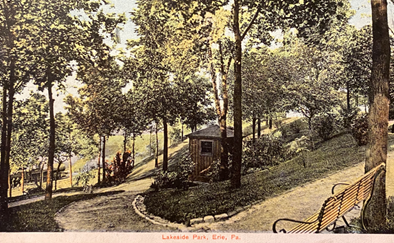
Overall, Nolen recommended that the State of Pennsylvania get involved with the development of not only Lake Erie shipping and infrastructure but also of rivers that ship goods, similar to Pittsburgh. In 1921 Presque Isle was state owned property but not a state park. A viaduct was to be created from the bluffs in Erie to the harbor front (isn’t that what PennDot is recommending now with the development of a bayfront roundabout and walkway over the street for pedestrian use?). He suggested a viaduct wide enough so that room could be given to trolley traffic, automobiles, and two, eight-foot-wide sidewalks. He also requested that a dry-docking facility be constructed.
My favorite recommendation by this practical, insightful consultant was that the waterfront area in the city west of the Steamboat Landing would be developed for recreational use and the east side for shipping and commercial use. Wouldn’t that be great today? The Erie Western PA Port Authority exists to improve our waterfront but there is still work to be done. I support them and all the folks who work to improve our community!
